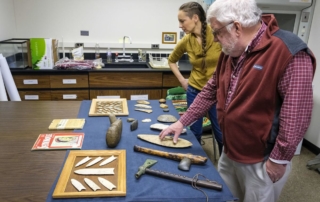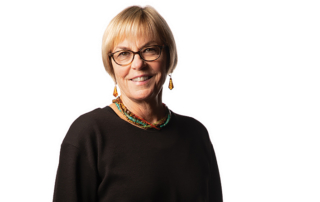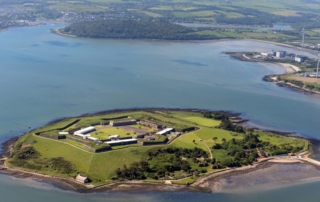The Southern Illinoisan: 40 years later, Southern Illinois archaeologist’s finds return to SIU, shedding light on early cultures
CARBONDALE — Like many prolific people, Irvin Peithmann’s documents, writings, photographs and artifacts became dispersed over his career and after his death in 1981. But the amateur archaeologist’s work has found its way home to Southern Illinois at the perfect time. Peithmann discovered a passion for archaeology in boyhood, unearthing arrowheads while working the plow on his family’s Washington County farm. By Byron Hetzler Dec 19, 2019
Phys.org: Traveling back in time through smart archaeology
The British explorer George Dennis once wrote, "Vulci is a city whose very name … was scarcely remembered, but which now, for the enormous treasures of antiquity it has yielded, is exalted above every other city of the ancient world." He's correct in assuming that most people do not know where or what Vulci is, but for explorers and historians—including Duke's Bass Connections team Smart Archaeology—Vulci is a site of enormous potential. by Meghna Datta, Duke Research Blog, Duke University December 10, 2019
Archaeology In The Digital Age: Invisible Archaeology & Digital Displays At The Museo Egizio, Turin
Invisible Archeology (Archeologia Invisibile), is the current temporary exhibit at the Museo Egizio (Egyptian Museum), in Turin, Italy, which runs from March 13, 2019 to January 16, 2020. The exhibit aims to connect visitors to the biography of objects through archaeometry – scientific analyses and digital tools used in archaeological investigations. Each summer, I run a field school on Museology and Egyptian Material Culture at the museum, through IFR (the Institute for Field Research), and was able to take advantage of the exhibit to explore the potential of digital technologies in a museum setting with two groups of our students. By Dr. Caroline Arbuckle MacLeod August 8, 2019
Duke Today: Where The Scholarly Work Takes Them: Summer allows Duke faculty members to follow their curiosity far from campus
For Maurizio Forte, professor in Duke’s Department of Art, Art History and Visual Studies, there is plenty to teach his students in the classroom. But some lessons are best taught in the windblown countryside of central Italy. For the past six summers, Forte has brought Duke students to the Vulci archeological excavation site to use traditional techniques and cutting-edge technology to examine what was once an Etruscan and Roman city. By: Stephen Schramm July 15, 2019
Seattle Business Magazine: 2019 Executive Excellence Awards: Julie Stein, Burke Museum of Natural History and Culture
The executive director of the Seattle museum is one of this year's winners. Geoarchaeologist, Dr. Julie Stein is an IFR Board Member By: Bill Virgin |From The Print Edition | February 2019
The Common Descent Podcast: Voices of La Brea – Bonus Episode
We were in southern California for NAPC recently, so we sat down with a bunch of the crew from La Brea to get some insights into their work, their history, and their favorite things about the site. In this audio, you’ll hear from: Dr. Emily Lindsey, Assistant Curator and Excavation Site Director and more! August 10, 2019
U of Arkansas: Geosciences’ Fred Limp Reappointed by Secretary of Interior to Federal Board
Secretary of Interior David Bernhardt has reappointed Fred Limp, University Professor of geosciences and the Leica Chair, to a second four-year term on the Preservation and Technology Training Federal Advisory Board. The board advises the Department of Interior's National Center for Preservation Technology and Training. The center helps preservationists find better tools, better materials, and better approaches to conserving buildings, landscapes, sites, and collections. March 07, 2019
The Sofia Globe: Sixth-century terracotta ‘mask’ of emperor found in Bulgaria’s Varna
An artefact made of terracotta has been discovered at the Dzhanavara site in the Bulgarian Black Sea city of Varna, a news conference at the Regional Archaeological Museum was told on February 12. The find, made during excavations of an early Christian monastery, is part of a mask or bust and most likely portrays an emperor’s face. It is estimated to date back to the sixth century. February 12, 2019
New York Times: Why Are Antiques So Cheap? Because Everyone Lives in the Kitchen
The 18th-century oak bureau was expected to sell for at least 50 pounds, or about $65. IFR board member, Dr. Anthony Graesch, provides insights on modern day material culture and household ethnoarchaeology in this article. Oct 26, 2018
CNN Travel: Spike Island: Unraveling the mysteries of ‘Ireland’s Alcatraz’
A star-shaped fortress atop a picturesque island off the southwest coast of Ireland once housed one of the world's biggest prison populations. While today Spike Island welcomes boatloads of tourists -- much like Alcatraz in San Francisco Bay or Robben Island off the coast of South Africa -- in Victorian times it was a place that many never left, with more than 1,000 prisoners dying there in less than four years. In an attempt to learn more about the men who perished on this prison island, bioarchaeologist Barra O'Donnabhain began excavating the convict graveyard in 2013. Over the past five years, O'Donnabhain and his team have uncovered some of the mysteries buried on Spike Island -- including a grizzly procedure long ago carried out [...]











